|
Messerschmitt Bf 109G-6
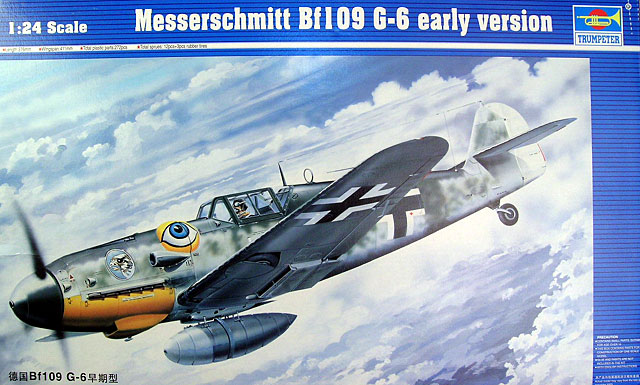
Trumpeter
S u
m m a r y
|
| Catalogue Number: |
02407 |
| Scale: |
1/24 |
| Contents and Media: |
272 parts in light grey and clear
injection molded plastic; metal shafts for ailerons and flaps; rubber
tyres and ignition harness; photo-etched parts for control surface hinges;
2 x springs; markings for two aircraft |
| Price: |
USD$89.97
from Squadron.com |
| Review Type: |
QuickLook |
| Advantages: |
Accurate outline compared to
respected drawings; two sets of fuselage halves supplied (option of clear
or grey styrene); constant and crisply engraved panel lines; restrained
flush rivet detail; good quality mouldings; nice attention to detail;
workable control surfaces; nicely detailed engine and cockpit parts; very
thin, clear and accurate transparent parts; includes drop tank, gondola
cannon and G-5 cowling bulge as options |
| Disadvantages: |
Galland Panzer armoured glass in
grey plastic; some ejector pin marks in visible locations; scuffed clear
parts; a few "early version" parts not included. |
| Recommendation: |
Recommended. |
Reviewed by
Brett Green

Trumpeter's
1/24 scale Messerschmitt Bf 109G-6 may be ordered online from Squadron.com
Trumpeter is simultaneously releasing two variants of the
Messerschmitt Bf 109G in 1/24 scale - the Bf 109G-2 and the Bf 109G-6, early
version.
The subject of this review, the Bf 109G-6 kit, comprises 272
injection molded parts in grey plastic and clear styrene (including a
second set of fuselage halves in clear plastic), rubber tyres, a small bag
of metal rods, a photo-etched fret with hinges for control surfaces and an
acetate sheet with printed instruments and markings by Aeromaster Decals for
two aircraft.
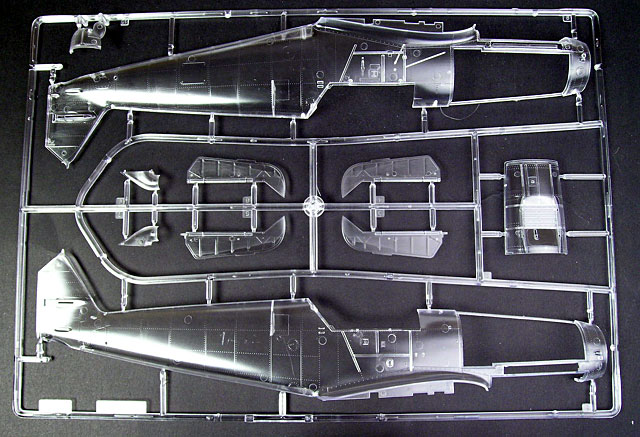
Click the thumbnails below to
view larger images:
The parts are perfectly moulded with crisply engraved panel
lines, supplemented with subtle rows of recessed "flush rivets". Although
surface detail is a very subjective issue, I think that this is Trumpeter's
best representation of surface features to date.
Fabric surface detail on the control surfaces is represented
by simple raised ridges. The texture is more restrained than earlier efforts
but will still benefit from a few swipes of the sanding stick.
Two sets of canopies are supplied. The transparent parts are
thin and clear, but the opening section of each canopy is scuffed on a section
of the inside. This scuffing looks like some sort of mould flaw and will
require a few minutes polishing to correct the problem. The clear instrument
panel is also very thin, and should look good overlaying the acetate
instruments after a coat of paint..
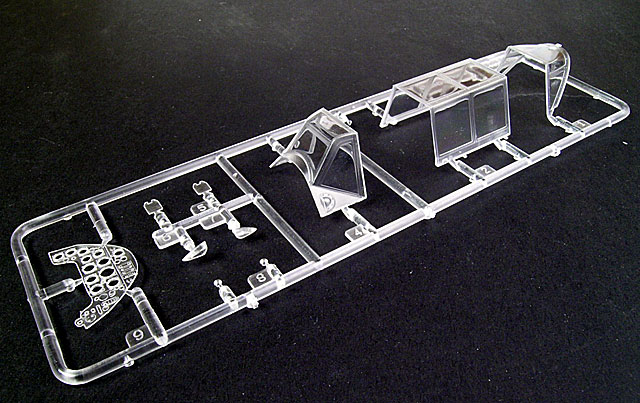
All control surfaces, including slats and flaps, are workable
due to the inclusion of hinges made from etched metal and steel rod. The
undercarriage gear is sprung, but (mercifully) does not retract. The small
louvres at the front of the radiators are supplied as separate parts and may
be positioned open or closed. Actuator struts are also included. Cowl scoops
are moulded onto the kit nose and are open at the front.
The cockpit looks pretty good. Some detail is moulded onto the
sidewalls, with separate parts added to this area. A harness is not included.
The engine appears to be a decent basis for additional
detailing. I especially like the individual exhaust stacks; each pipe split
down the centreline and hollow at the end. The cowl machine gun barrels are
hollowed out, saving the modeller some extra work.
Optional parts include two 20mm underwing gondolas. Indeed,
the kit even incorporates the circular ammunition drum for each gondola
inside the wing. This level of detail extends to the lower fuselage shell
ejection panel, which includes open holes for the chutes.
A 300 litre drop tank, alternate style wheel hubs, a DF loop
and short antenna mast are also included. Although not mentioned in the
instructions or parts list, a tall rudder is on Sprue H. A little plastic
surgery would be required to the tip of the kit fin to fit this rudder, but it
would not be hard to make this modification if desired.
The Galland Panzer pilot's armour is moulded as a single solid
grey plastic part. This style of pilot's head armour is more common to later
G-6 aircraft, and in any case should be fitted with armoured glass. You'll
need to cut out the centre of the plastic part and insert some clear plastic
if you want to use the Galland Panzer. Furthermore, the more common
early-style solid steel canopy armour is not included in the kit. Fortunately,
this will be simple enough to cut from plastic sheet. Similarly, the longer
antenna mast more frequently seen on early G-6s is not included but can be
easily cut from scrap plastic.
It is nice to see additional detail on the canopy parts
including handgrips on the windscreen, canopy release lever and slide-window
knobs.
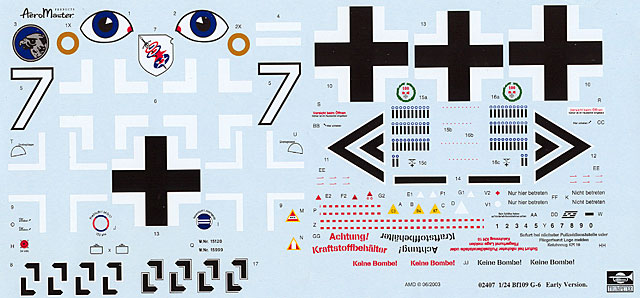
The kit decals represent a vast improvement over earlier
releases in Trumpeter 1/24 scale kits.
Decals are produced by Aeromaster and cover two interesting
subjects. Both have appeared on Aeromaster sheets in other scales. The decals
are thin and in perfect register.
Test Fitting
I have test-fitted the fuselage and wing parts. The fuselage
halves fit together well, and the wings appear to mate with the fuselage
without problems. Of course, this does not guarantee a perfect fit when the
engine, cockpit and controls surfaces are installed, but so far, so good.
Dihedral looks correct too.
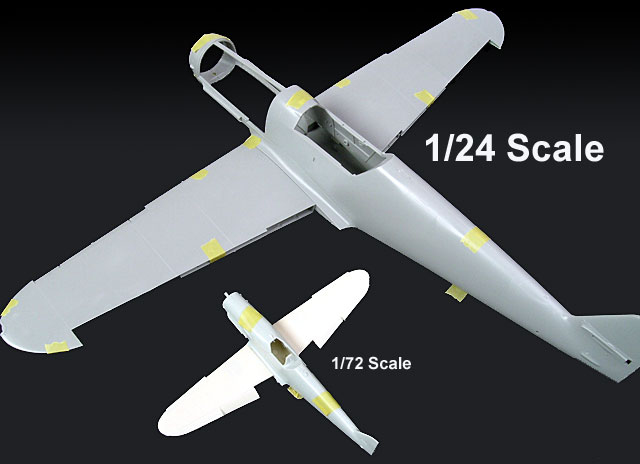
The photo above demonstrates the size difference between the test-fitted
Trumpeter kit and the Revell 1/72 scale Bf 109G-10.
Accuracy
I compared the fuselage of Trumpeter's 1/24 scale
Messerschmitt Bf 109G-6 with plans in my book, "Augsburg's Last Eagles",
published by Eagle Editions. The plans were scaled up from 1/48 to 1/24.
Dimensions matched almost perfectly.
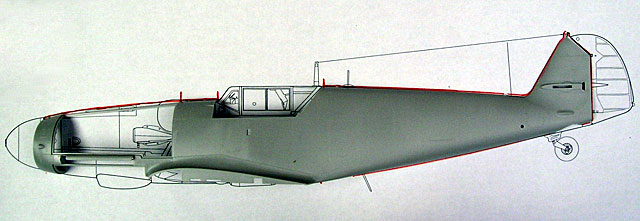
The depth and shape of the fuselage components looked
excellent but there was a tiny discrepancy around the rear fuselage. Heading
toward the tail, the fuselage is angled slightly upward compared to the
drawings. At the mid-fuselage, the kit part is a little more than a millimetre
deeper than indicated on the drawing. Minor dimensions look good, even in
tricky areas like the space between the front of the windscreen and the back
of the engine cowl.
The wings also compare very closely to plans, this time scaled
up from the Aero Detail book on the Bf 109G.
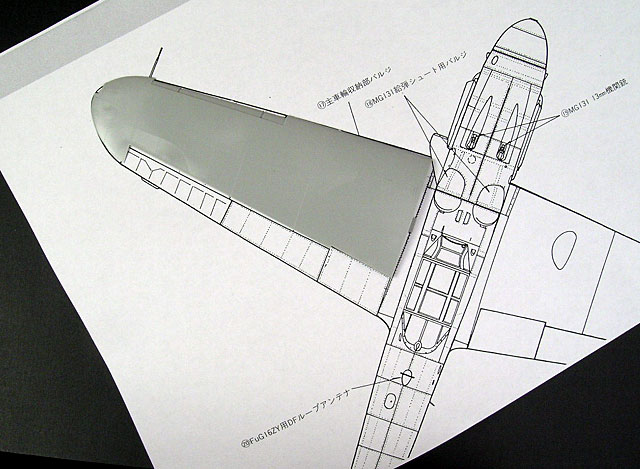
Overall, accuracy looks very good compared to these drawings.
In the box, the model certainly passes the eyeball test with flying colours
too.
Click the thumbnails below to
view larger images:
Be still my beating heart!
Trumpeter's recent 1/24 scale Spitfire Vb was good, and this
kit looks even better.
At first inspection, Trumpeter's 1/24 scale Messerschmitt Bf
109G-6 looks accurate, is well detailed, offers useful options, has excellent
surface texture and includes high-quality decals. The model should look
impressive straight from the box. With some extra effort it could be
breathtaking.
The few minor nitpicks such as the opaque Galland Panzer and
absence of tall aerial mast can be fixed with minimal effort. Some modellers
won't like the workable features, but their inclusion seems to be a matter of
philosophy as much as engineering.
Despite the large scale, the Bf 109 is quite petite so it will
be possible to display your finished model without hijacking the dining table.
Looks like I might have to order that Bf 109G-2 as well. Now,
where are all the aftermarket decal options for 1/24 scale Gustavs?
Recommended.
Review kit purchased with the Editor's funds
Text and Images Copyright © 2003 by
Brett Green
Page Created 26 August, 2003
Last updated
16 December, 2003
Back to
HyperScale Main Page
Back to
Reviews Page
|
Home | What's
New | Features
| Gallery |
Reviews | Reference
| Forum
| Search